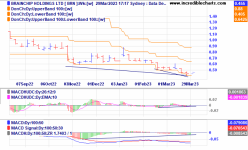May have been posted but a good reminder to keep a watch for confirmation of whose Ai Renesas teamed up with ARM's M85 Cortex processor and the size of the MCU market that Renesas supplies each year and growing:
Renesas to Demonstrate First AI Implementations on the Arm Cortex-M85 Processor Featuring Helium Technology at Embedded World
By
IoT - Internet of Things
-
March 12, 2023
https://www.facebook.com/sharer.php?u=https://iot.do/renesas-to-demonstrate-first-ai-implementations-on-the-arm-cortex-m85-processor-featuring-helium-technology-at-embedded-world-2023-03
https://twitter.com/intent/tweet?text=Renesas+to+Demonstrate+First+AI+Implementations+on+the+Arm+Cortex-M85+Processor+Featuring+Helium+Technology+at+Embedded+World&url=https://iot.do/renesas-to-demonstrate-first-ai-implementations-on-the-arm-cortex-m85-processor-featuring-helium-technology-at-embedded-world-2023-03&via=IoTdo
https://pinterest.com/pin/create/button/?url=https://iot.do/renesas-to-demonstrate-first-ai-implementations-on-the-arm-cortex-m85-processor-featuring-helium-technology-at-embedded-world-2023-03&media=https://iot.do/wp-content/uploads/sites/2/2023/03/m85-ai.jpg&description=Microcontroller Leader to Showcase Superior Performance of New Processor in Demanding AI Use Cases at Embedded World 2023 Exhibition and Conference
https://api.whatsapp.com/send?text=Renesas+to+Demonstrate+First+AI+Implementations+on+the+Arm+Cortex-M85+Processor+Featuring+Helium+Technology+at+Embedded+World https://iot.do/renesas-to-demonstrate-first-ai-implementations-on-the-arm-cortex-m85-processor-featuring-helium-technology-at-embedded-world-2023-03

Renesas Electronics Corporation will present the first live demonstrations of artificial intelligence (AI) and machine learning (ML) implementations on an MCU based on the Arm® Cortex®-M85 processor. The demos will show the performance uplift in AI/ML applications made possible by the new Cortex-M85 core and Arm’s Helium technology. They will take place in the Renesas stand – Hall 1, Stand 234 (1-234) at the embedded world 2023 Exhibition and Conference in Nuremburg, Germany from March 14-16.
At embedded world in 2022, Renesas became the first company to demonstrate working silicon based on the Arm Cortex-M85 processor. This year, Renesas is extending its leadership by showcasing the features of the new processor in demanding AI use cases. The first demonstration showcases a people detection application developed in collaboration with Plumerai, a leader in Vision AI, that identifies and tracks persons in the camera frame in varying lighting and environmental conditions. The compact and efficient TinyML models used in this application lead to low-cost and lower power AI solutions for a wide range of IoT implementations. The second demo showcases a motor control predictive maintenance use case with an AI-based unbalanced load detection application using Tensorflow Lite for Microcontrollers with CMSIS-NN.
Delivering over 6 CoreMark/MHz, Cortex-M85 enables demanding IoT use cases that require the highest compute performance and DSP or ML capability, realized on a single, simple-to-program Cortex-M processor. The Arm Cortex-M85 processor features Helium technology, Arm’s M-Profile Vector Extension, available as part of the Armv8.1M architecture. It delivers a significant performance uplift for machine learning (ML) and digital signal processing (DSP) applications, accelerating compute-intensive applications such as endpoint AI. Both demos will showcase the performance uplift made possible by the application of this technology in AI use cases. Cortex-M hallmarks such as deterministic operation, short interrupt response time, and state-of-the-art low-power support are uncompromised on Cortex-M85.
“We’re proud to again lead the industry in implementing the powerful new Arm Cortex-M85 processor with Helium technology,” said Roger Wendelken, Senior Vice President in Renesas’ IoT and Infrastructure Business Unit. “By showcasing the performance of AI on the new processor, we are highlighting technical advantages of the new platform and at the same time demonstrating Renesas’ strengths in providing solutions for emerging applications with our innovative ecosystem partners.”
“We’re excited to take part in this ground-breaking demonstration,” said Roeland Nusselder, CEO of Plumerai. “Arm’s Helium technology supported on the new RA MCUs with the Cortex-M85 core significantly accelerates the Plumerai inference engine. This performance uplift will enable our customers to use larger and more accurate versions of Plumerai’s People Detection AI, add additional product features, and extend battery life. Our customers have an insatiable appetite for adding new and more accurate AI features that run on a microcontroller. Together with Renesas, we are the first to fulfill this demand.”
Renesas will implement the new Arm processor within its RA (Renesas Advanced) Family of MCUs. Renesas has quickly become a leader in the Arm MCU market, offering a feature rich family of over 250 different MCUs. Renesas has developed a robust ecosystem of partners providing customers with comprehensive solutions for IoT, AI/ML, industrial automation, medical, building automation, home appliance and multiple other applications.
The new Cortex-M85 core supports Arm TrustZone® technology for protection of secure assets. Combined with TrustZone, Renesas’ integrated cryptographic engine, immutable storage, key management, and tamper protection against DPA/SPA side-channel attacks will provide a comprehensive and fully integrated secure element functionality. The Armv8-M architecture also brings Pointer Authentication/Branch Target Identification (PAC/BTI) security extension, a new architectural feature that provides enhanced mitigation from software attack threats and helps achieve PSA Certified Level 2 certification.
The new RA MCUs based on the Cortex-M85 core will be supported by Renesas’ Flexible Software Package (FSP). The FSP enables faster application development by providing all the infrastructure software needed, including multiple RTOS, BSP, peripheral drivers, middleware, connectivity, networking, and security stacks as well as reference software to build complex AI, motor control and graphics solutions. It allows customers to integrate their own legacy code and choice of RTOS with FSP, thus providing full flexibility in application development. Using the FSP will ease migration of existing designs to the new RA devices.
Winning Combinations
Renesas will combine the new RA MCUs with numerous compatible devices from its portfolio to offer a wide array of Winning Combinations. These Winning Combinations are technically vetted system architectures from mutually compatible devices that work together seamlessly to bring an optimized, low-risk design for faster time to market. Renesas offers more than 300 Winning Combinations with a wide range of products from the Renesas portfolio to enable customers to speed up the design process and bring their products to market more quickly. They can be found at renesas.com/win.
Renesas MCU Leadership
A world leader in MCUs, Renesas ships more than 3.5 billion units per year, with approximately 50% of shipments serving the automotive industry, and the remainder supporting industrial and Internet of Things applications as well as data center and communications infrastructure. Renesas has the broadest portfolio of 8-, 16- and 32-bit devices, and is the industry’s No. 1 supplier of both 16- and 32-bit MCUs, delivering unmatched quality and efficiency with exceptional performance. As a trusted supplier, Renesas has decades of experience designing smart, secure MCUs, backed by a dual-source production model, the industry’s most advanced MCU process technology and a vast network of more than 200 ecosystem partners."
My opinion only DYOR
FF
AKIDA BALLISTA






